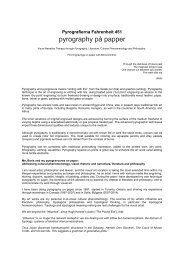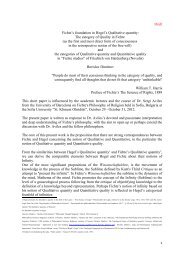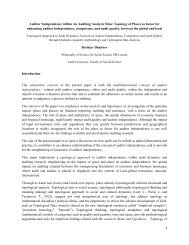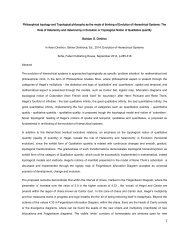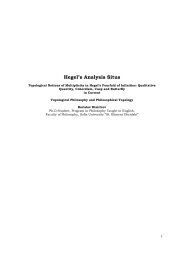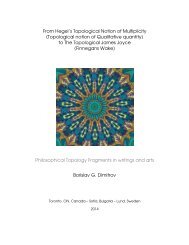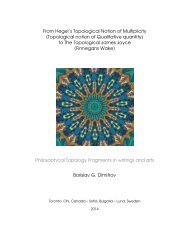Topological Ontology and Logic of Qualitative quantity
Qualitative quantity and BFO (Basic Formal Ontology) of /Barry Smith/ and YAMATO (Yet Another More Advanced Top-level Ontology) of /Riichiro Mizoguchi/
Qualitative quantity and BFO (Basic Formal Ontology) of /Barry Smith/ and YAMATO (Yet Another More Advanced Top-level Ontology) of /Riichiro Mizoguchi/
- No tags were found...
Create successful ePaper yourself
Turn your PDF publications into a flip-book with our unique Google optimized e-Paper software.
3. The <strong>Topological</strong> Notion <strong>of</strong> <strong>Qualitative</strong> <strong>quantity</strong><br />
Back in 1989, as a Research Associate at Institute for Philosophical Research at Bulgarian<br />
Academy <strong>of</strong> Science, I have established the qualitative <strong>quantity</strong> as vocamen <strong>of</strong> my research<br />
interests in philosophy or topological philosophy. In two papers “Quality <strong>of</strong> <strong>quantity</strong>”<br />
(1989) 39 <strong>and</strong> “Quality <strong>and</strong> Time” (1990) 40 , I have focused on the resurgence <strong>of</strong> G.F.W.<br />
Hegel’s category “qualitative <strong>quantity</strong>” historically left “inapparent” arguing that this<br />
category is the real breakthrough from the cliche <strong>of</strong> the known law <strong>of</strong> dialectics – the the<br />
law <strong>of</strong> transformation <strong>of</strong> <strong>quantity</strong> to quality <strong>and</strong> the appearance <strong>of</strong> the new quality as<br />
qualitative leap.<br />
Due to the gradual <strong>and</strong> continuous notion <strong>of</strong> qualitative <strong>quantity</strong>, linking Henri Poincare’s<br />
Analysis Situs with Hegel’s qualitative <strong>quantity</strong>, I proposed the argument that the exhibit<br />
form <strong>and</strong> notion <strong>of</strong> the <strong>Qualitative</strong> <strong>quantity</strong> is Topology <strong>and</strong> topological homeomorphism.<br />
Today in the recent work on my PhD thesis I tend to link the exhibit form <strong>of</strong> Hegel’s<br />
qualitative <strong>quantity</strong> with the topological cobordism. 41<br />
Back in 1989, in my first article, based on the exploration <strong>of</strong> D'Arcy W. Thompson’s<br />
(“Growth <strong>and</strong> Form”,1917) findings <strong>and</strong> examples, extracted from Hermann Haken 42 , who<br />
is illustrating the qualitative <strong>quantity</strong> notion in the structural stability, I have argued that<br />
topology is the field <strong>of</strong> qualitative <strong>quantity</strong> <strong>and</strong> topological homeomorphism is exhibit form<br />
<strong>of</strong> this category. The <strong>Qualitative</strong> <strong>quantity</strong> is applicable to the complex dynamic systems as<br />
complimentary method to the qualitative <strong>and</strong> quantitative approaches <strong>and</strong> methods in the<br />
paradigm shift from Typological to <strong>Topological</strong> thinking (Jay Lemke).<br />
From his reading <strong>of</strong> Hegel, Engels elucidated the three laws <strong>of</strong> dialectics in his “Dialectic <strong>of</strong><br />
Nature”. The second law <strong>of</strong> dialectics, the law <strong>of</strong> transformation, established by Engels is the<br />
law <strong>of</strong> the passage <strong>of</strong> quantitative changes into qualitative changes. This law states that<br />
continuous quantitative development results in qualitative "leaps" in nature whereby a<br />
completely new form or entity is produced. This is how "quantitative development becomes<br />
qualitative change". The new quality develops quantitatively through a step-by-step process<br />
<strong>of</strong> quantitative changes, qualitative changes begin with the quantitative introduction <strong>of</strong> the<br />
new quality into the quantitative development <strong>of</strong> the old measure. <strong>Qualitative</strong> changes<br />
occur as leaps. This Engels’s law <strong>of</strong> transformation <strong>and</strong> the passage <strong>of</strong> quantitative changes<br />
into qualitative changes, as all <strong>of</strong> the three laws <strong>of</strong> Engels’s dialectics become cliché in the<br />
mode <strong>of</strong> thinking <strong>of</strong> quality <strong>and</strong> <strong>quantity</strong>. The three laws <strong>of</strong> dialectics are not only<br />
oversimplified, but also misleading at best, establishing something quite self-evident, trivial<br />
<strong>and</strong> commonplace. Gradualness <strong>and</strong> gradual changes which are not leading to turning<br />
points, where one force overcomes the other <strong>and</strong> quantitative change leads to qualitative<br />
change, remained inapparent just like Hegel’s dialectics <strong>of</strong> <strong>Qualitative</strong> <strong>quantity</strong>.<br />
Approaching the domain <strong>of</strong> topology from the st<strong>and</strong>point <strong>of</strong> the dialectics <strong>of</strong> qualitative<br />
<strong>quantity</strong>, we should conclude that the interplay <strong>of</strong> quality <strong>and</strong> quality is associated with the<br />
39 Borislav Dimitrov, “Quality <strong>of</strong> the Quantity”,“Philosophic Thought Magazine”, March, 1989, Institute <strong>of</strong><br />
Philosophical Sciences, Bulgarian Academy <strong>of</strong> Science<br />
40 Borislav Dimitrov, “Quality <strong>and</strong> Time”, presented at the conference “The Fundamental Knowledge between<br />
<strong>Ontology</strong> Dilemma <strong>and</strong> Cognitive Problems”, 1990, Institute <strong>of</strong> Philosophical Sciences, Bulgarian Academy <strong>of</strong><br />
Science<br />
41 Borislav Dimitrov, <strong>Logic</strong> <strong>and</strong> Hermeneutics Topo(logic)ally Approached - From Hans-Georg Gadamer’s<br />
essay “The Idea <strong>of</strong> Hegel’s <strong>Logic</strong>” to the <strong>Topological</strong> Approach in-to Hermeneutics (2012):<br />
http://ariadnetopology.org/Gadamer.pdf, Borislav Dimitrov, Cultural Phenomenology <strong>of</strong> Law <strong>and</strong> <strong>Topological</strong><br />
Approach to Law,(2012): http://ariadnetopology.org/1PDF.pdf<br />
42<br />
Hermann Haken, “Synergetics: Introduction <strong>and</strong> Advanced Topics”, 1983, Springer (Chapter 1.13.<br />
<strong>Qualitative</strong> Changes: General approach, p. 434-435)<br />
23





